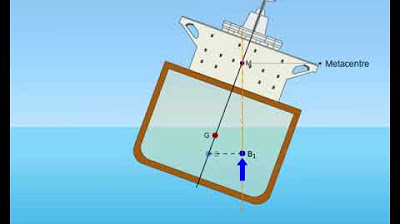S1E7: A Symphony of Neutral Buoyancy:Mastering the underwater dance #scubadiving #diving #underwater
Summary
TLDRThe video script 'A Symphony of Neutral Buoyancy' explores the art of achieving perfect balance underwater through neutral buoyancy, a skill essential for scuba divers. It emphasizes the importance of the Buoyancy Control Device (BCD) and breath control, along with techniques like the 'fin pivot' and body positioning to minimize environmental impact and maximize diving efficiency. The mastery of this skill not only enhances personal enjoyment but also plays a crucial role in conservation, offering extended dive times and improved photographic opportunities with marine life.
Takeaways
- 🤿 Achieving neutral buoyancy is the pinnacle of scuba diving skill, allowing divers to move gracefully and effortlessly underwater.
- 🎭 Mastering neutral buoyancy is an art form that requires practice, patience, and understanding of various factors affecting buoyancy.
- 🚪 It is the gateway to unlocking the full potential of scuba diving, transforming a simple dive into an immersive experience.
- 🏝️ Good buoyancy control is essential for conservation, allowing interaction with the underwater world with minimal impact.
- 🔄 The Buoyancy Control Device (BCD) and breath control are key elements in achieving neutral buoyancy, with the BCD allowing for adjustments by adding or releasing air.
- 🌀 Lung volume and breath control play a significant role in fine-tuning a diver's buoyancy, with inhaling increasing buoyancy and exhaling decreasing it.
- 🧘♂️ Finding the balance point in neutral buoyancy control is about becoming one with the water and moving effortlessly.
- 🤸♀️ Techniques like the 'fin pivot' help divers gauge their buoyancy and find the neutral buoyancy point by lifting off the seabed while breathing in.
- 🏊♂️ Body positioning and trim are crucial for minimizing drag and improving control, with even slight changes significantly impacting buoyancy.
- 🦵 Experimenting with different finning techniques can help divers find the most efficient movement for their style and conserve energy.
- 🌳 Mastering neutral buoyancy reduces air consumption, extends dive times, and prevents accidental damage to marine life and coral reefs.
- 📸 With improved stability and control, neutral buoyancy allows for capturing high-quality photographs and videos of marine life without disturbance.
- 🚀 It is a journey of dedication, practice, and learning, starting in controlled environments and seeking guidance from experienced instructors.
Q & A
What is neutral buoyancy in scuba diving?
-Neutral buoyancy is the state in scuba diving where the diver is perfectly balanced in the water, neither sinking nor floating.
Why is achieving neutral buoyancy considered a pinnacle of scuba diving skill?
-Achieving neutral buoyancy requires practice, patience, and a deep understanding of the interplay between several factors, making it a delicate dance between the diver, their equipment, and the underwater environment.
How does neutral buoyancy enhance the scuba diving experience?
-Neutral buoyancy transforms a simple descent into a truly immersive and awe-inspiring experience, allowing for minimal impact on the underwater environment and enhancing personal enjoyment and conservation efforts.
What are the two key elements at the heart of neutral buoyancy?
-The two key elements are the Buoyancy Control Device (BCD) and breath control.
How does the Buoyancy Control Device (BCD) function?
-The BCD allows for adjustments in buoyancy by adding or releasing air, which is crucial for counteracting changes in depth and the compressing effects of water pressure on a diver's wetsuit.
What role does breath control play in achieving neutral buoyancy?
-By taking slow, deep breaths, divers can subtly adjust their overall buoyancy. Inhaling slightly increases buoyancy, while exhaling decreases it.
What is the 'fin pivot' technique and its purpose?
-The 'fin pivot' technique helps divers gauge their buoyancy. By kneeling on the seabed and gently breathing in, a diver can find the point where their body lifts off the bottom, indicating neutral buoyancy.
Why is body positioning important in achieving neutral buoyancy?
-A streamlined, horizontal position minimizes drag and improves control. Even slight changes in trim, or the angle of the body in the water, can significantly impact buoyancy.
What benefits does mastering neutral buoyancy offer beyond personal satisfaction?
-Mastering neutral buoyancy reduces air consumption, prevents accidental contact with delicate marine life, and opens up opportunities for capturing stunning underwater photographs and videos.
How should a diver begin practicing to master neutral buoyancy?
-Divers should start by practicing in a controlled environment, such as a swimming pool or shallow dive site, experiment with their BCD, focus on slow, deep breaths, and seek guidance from experienced instructors.
Outlines

Dieser Bereich ist nur für Premium-Benutzer verfügbar. Bitte führen Sie ein Upgrade durch, um auf diesen Abschnitt zuzugreifen.
Upgrade durchführenMindmap

Dieser Bereich ist nur für Premium-Benutzer verfügbar. Bitte führen Sie ein Upgrade durch, um auf diesen Abschnitt zuzugreifen.
Upgrade durchführenKeywords

Dieser Bereich ist nur für Premium-Benutzer verfügbar. Bitte führen Sie ein Upgrade durch, um auf diesen Abschnitt zuzugreifen.
Upgrade durchführenHighlights

Dieser Bereich ist nur für Premium-Benutzer verfügbar. Bitte führen Sie ein Upgrade durch, um auf diesen Abschnitt zuzugreifen.
Upgrade durchführenTranscripts

Dieser Bereich ist nur für Premium-Benutzer verfügbar. Bitte führen Sie ein Upgrade durch, um auf diesen Abschnitt zuzugreifen.
Upgrade durchführenWeitere ähnliche Videos ansehen
5.0 / 5 (0 votes)






